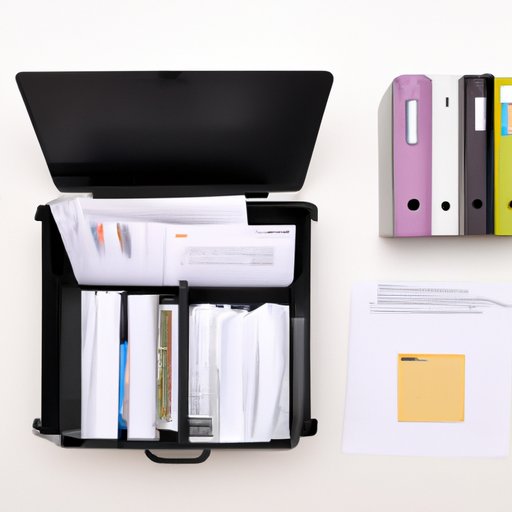
Introduction
Running out of storage on your MacBook can be a headache, especially if you rely on your computer for work or entertainment. Luckily, there are several ways you can free up space on your MacBook. In this article, we will cover five tips for clearing up space on your MacBook. Whether you’re a newbie or an experienced user, you’ll find something here to help you reclaim those precious gigabytes of storage.
5 Tips for Clearing Up Space on Your MacBook
Here are five tips for clearing up space on your MacBook:
Tip 1: Delete old files
Take some time to go through your files and delete anything you no longer need. Old essays, pictures, and music files are good places to start. You can sort by date to help you find the oldest files. Remember to check your Downloads folder and empty your trash too.
Tip 2: Uninstall unused apps
Look through your applications folder and delete any apps you no longer use. Unused applications take up precious storage space on your MacBook. You can easily uninstall an app by dragging it from the Applications folder to the Trash.
Tip 3: Use cloud storage services
There are several cloud storage services that allow you to store your files remotely. Some popular services include Dropbox, iCloud, and Google Drive. Storing files in the cloud helps to free up space on your MacBook. Just be sure to regularly clear out files you no longer need on your cloud storage accounts to prevent them from getting too full.
Tip 4: Clean up system files and logs
Your MacBook keeps logs of system activity that can take up a lot of space over time. Use a program like CleanMyMac X to scan and clean up system logs. You can also use it to clear out cache files, old iOS updates, and other junk files taking up space on your MacBook.
Tip 5: Use external storage devices
If you need to store large files or want to keep your important documents but don’t want them taking up space on your MacBook, then an external storage device is a good solution. You can use an external hard drive or a USB drive to store files outside of your main computer.
Maximizing Your MacBook’s Storage: A Guide to Decluttering and Organizing
Decluttering and organizing your files is another important step to maximizing your MacBook’s storage space. Here are some tips for decluttering and organizing your files:
Sorting, Naming, and Grouping Files
Sort your files into groups based on their purpose, such as work or personal files. Consider naming them so that they are easy to find and group together as well. For instance, if you have a lot of word documents, consider putting them all in one folder labeled “Word Docs.”
Creating Folders and Using Tags
Create a separate folder for important files that you want to keep but may not need to access frequently. Using tags can also be helpful in organizing files, as you can quickly search for specific items using tags such as “work,” “personal,” or “school.”
How to Optimize Your MacBook’s Storage and Keep it Running Smoothly
Here are some suggestions on how to optimize your MacBook’s storage and keep it running smoothly:
Using Storage Management and Optimized Storage
macOS has built-in storage management tools that can help you optimize your storage. Storage Management can easily identify large files and folders, and Optimized Storage can automatically clear up space when needed by removing old files that you have already backed up.
Regularly Deleting Files and Updating Software
It’s important to regularly delete files you no longer need and update the software on your MacBook. Updates sometimes contain fixes for storage-related bugs and can help you save space on your MacBook.
The Ultimate Guide to Clearing Out Space on Your MacBook
Now that we’ve covered some basic tips for clearing out space on your MacBook, let’s look at some advanced tips:
Clear Out iOS Backups and Old iOS Updates
iOS backups and updates can take up a lot of space on your MacBook. Delete old backups and updates using CleanMyMac X or manually by searching for them in Finder.
Clear Out Your Email Inbox
Email attachments, stored emails, and old drafts can quickly take up space in your email inbox. Consider deleting emails you no longer need or move them to the cloud.
Compress Large Files
You can also try compressing large files and folders to save space. Built-in compression tools in macOS are a good option here.
Storage Woes? Here’s How to Give Your MacBook a Fresh Start
If all else fails, and you have tried all the tips above, then restoring your MacBook to its factory settings can be an effective solution. Here’s how:
Step-by-Step Instruction for Restoring Your MacBook
You can restore your MacBook to its factory settings by following these instructions: Visit Apple support for detailed guidance
Reinstalling Necessary Apps and Files
You will need to reinstall any necessary apps and files after restoring your MacBook. Be sure to have a list of what you need handy, so you don’t forget anything important.
Conclusion
You don’t have to suffer from a full hard drive on your MacBook. By following the tips in this guide, you can free up space on your MacBook and keep it running smoothly. Whether you are a casual user or a power user, these tips are practical and easy to implement. So take action today and start enjoying your clean and organized MacBook.





